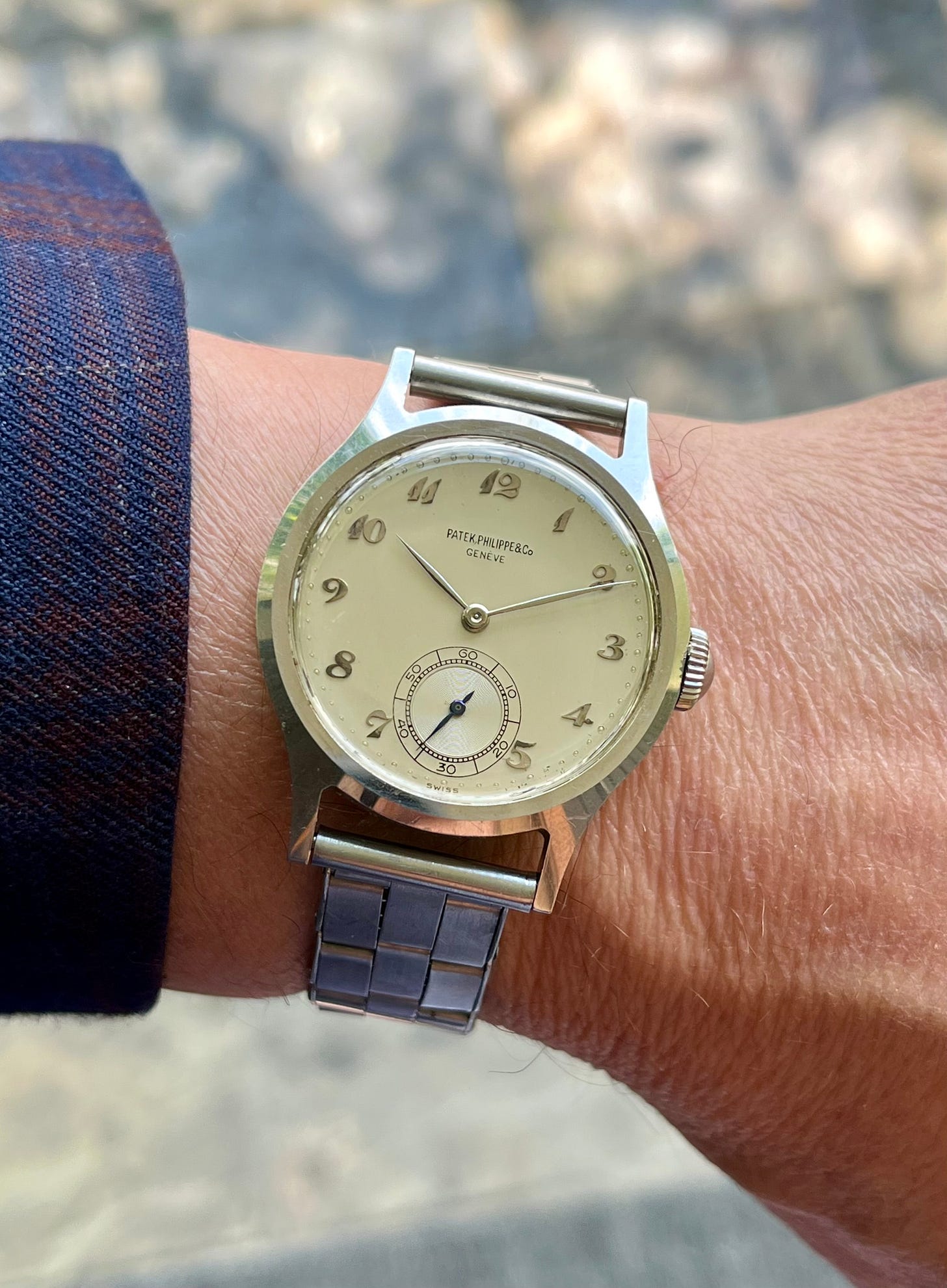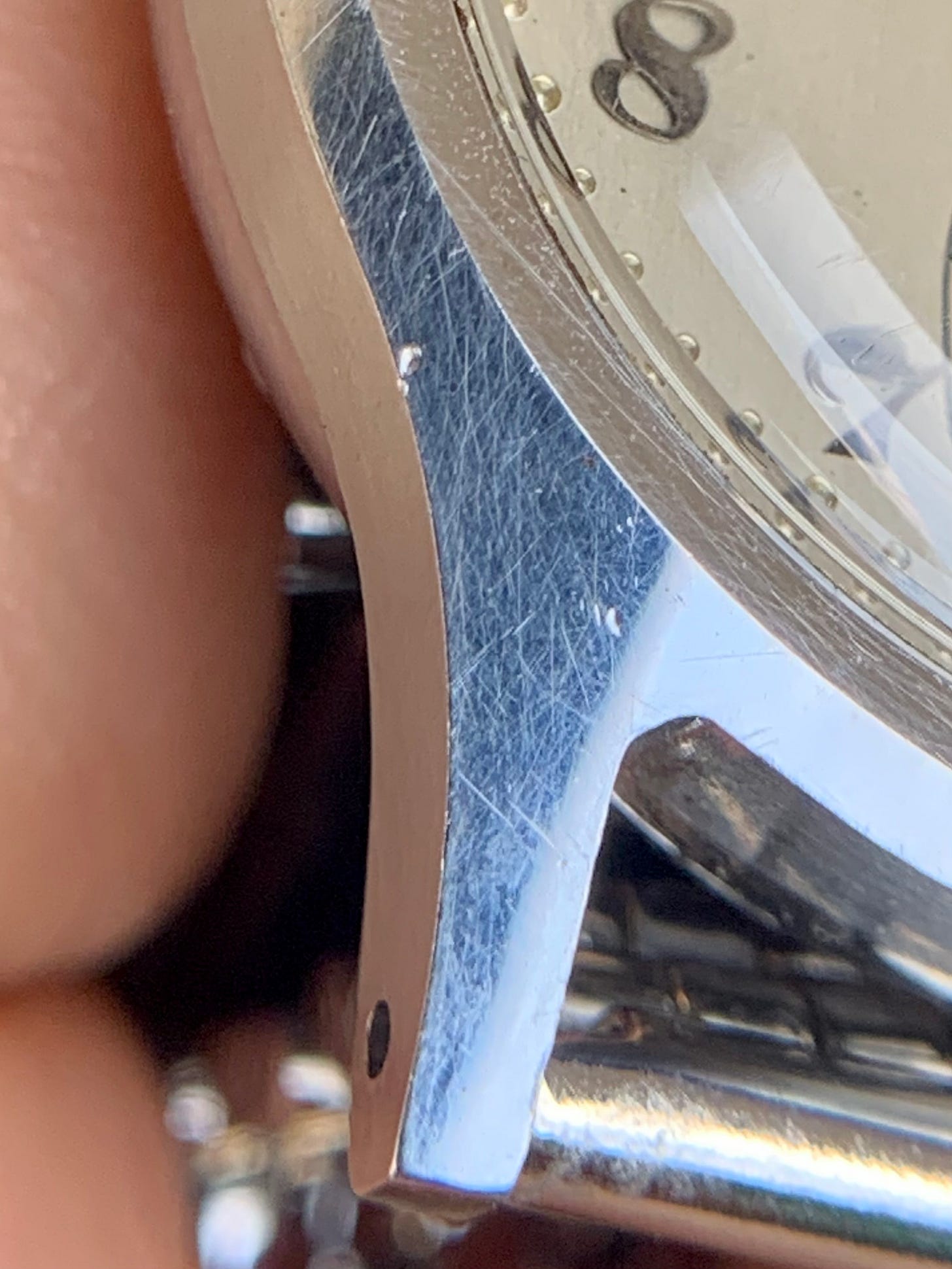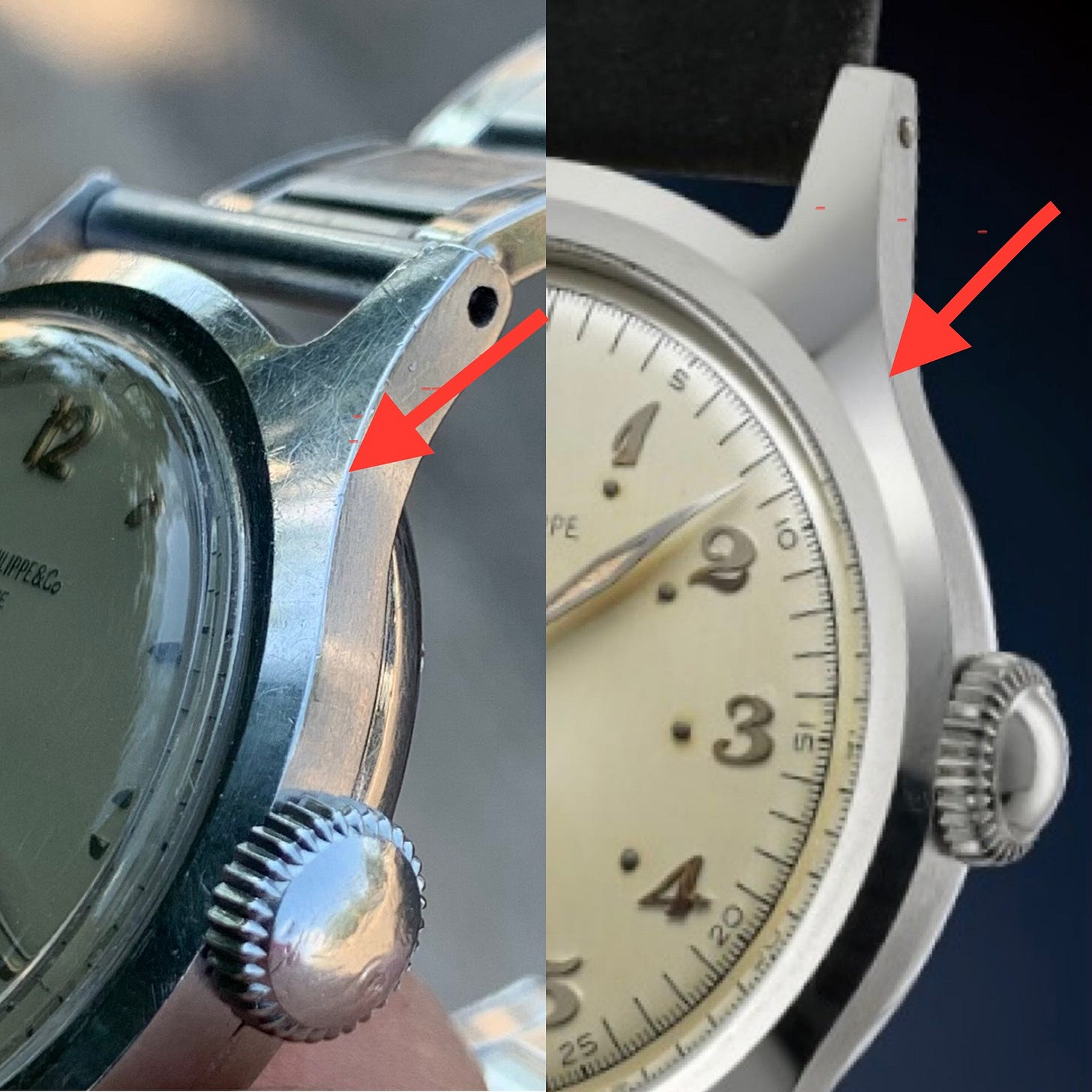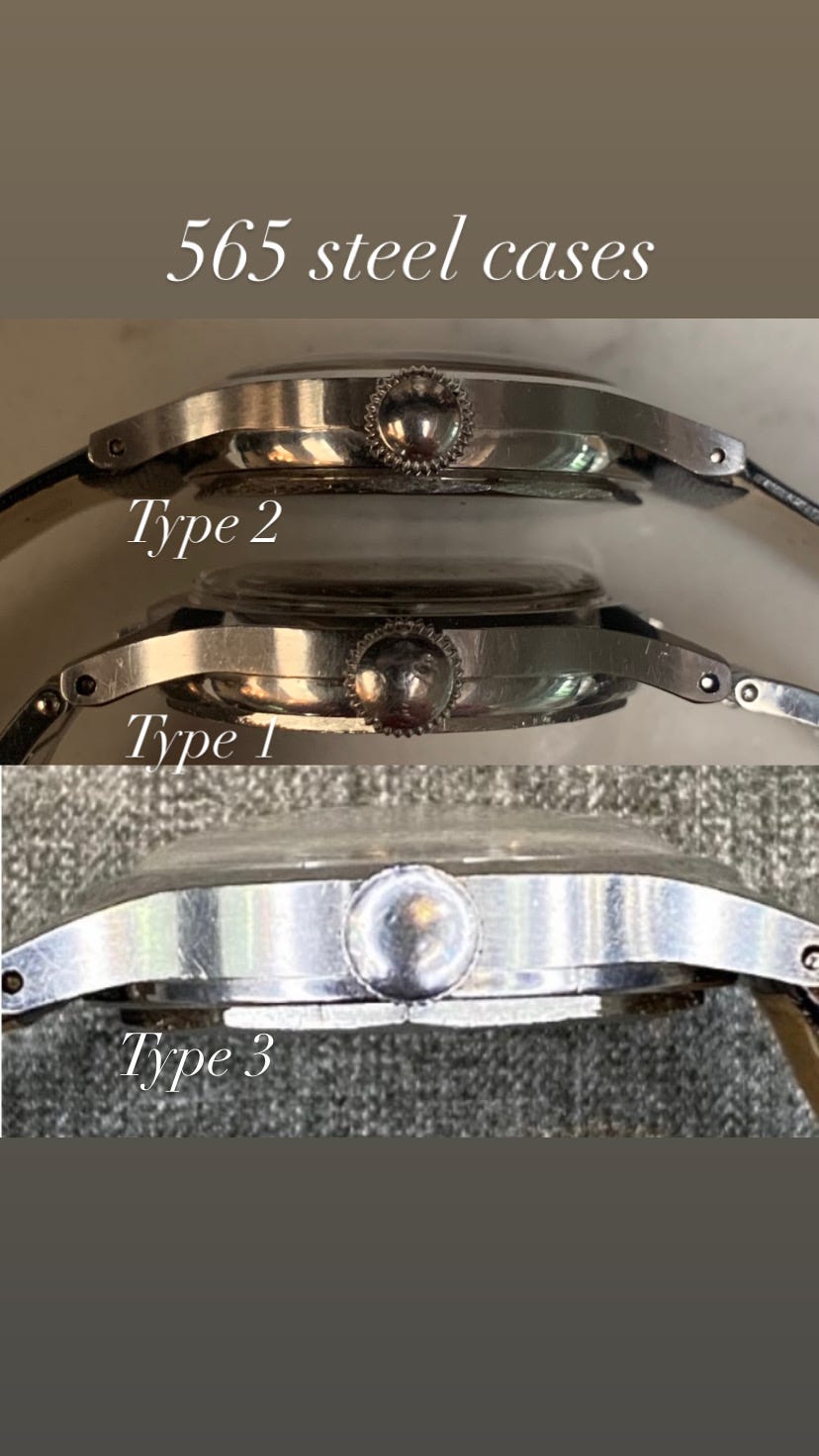(Fig. 1 - on the wrist)
Introduction
The Patek reference 565 is one of the icons and often sought references in the collecting pursuit of many vintage Patek enthusiasts. Even by today’s trends, these examples are very wearable and have a timeless, modernist design consisting of a monobloc case, sharp angles, screw back case with inner dustcover and ribbed winding crowns made by Boninchi. These crowns resemble an umbrella or priest cap. Interestingly, Boninchi was later acquired by Rolex (see some references to examples with Boninchi crowns via John Reardon’s published link Here and enjoy a virtual treasure trove of amazing Patek examples shown).
The production run of the 565 reference was from 1938 to 1952. It was then succeeded by the reference 2533. There were first and second series with sub seconds and with indirect and direct seconds movements manufactured during this run. The 565 was produced in descending order of rarity; Rose gold, Yellow gold and Steel. The present example is currently featured on a Gay Freres stretch rivet bracelet from the period (Figs. 2, 3).
(Figs. 2, 3 - Gay Freres stretch rivet bracelet)
The Dial
Many dial variations were produced during the manufacturing run and among the most coveted is the “Heures Penchees” otherwise known as leaning markers or Breguet dial. Subject version is extract confirmed as fitted with a Breguet dial. The steel Breguet markers are rhodium plated and some oxidation is noted on the markers in addition to different parts of the dial, which I personally like to see as a collector interested in eye pleasing signs of honest aging and patina. These markers were also individually cut, polished by hand, then affixed to the dial with a tool to secure them in a less than perfect application process when compared to today’s modern methods.
Honest originality is important to many collectors and often different levels of cleaning or restoration have been performed on these watches over time. The engraved enamel signature is also known as “indelible” or “tattoo”, given its resilience to abrasive cleaning methods used to remove stains and blemishes from the dial over time. Although these are resilient by design, on some examples signs of past cleaning or more invasive restoration are often evident upon inspection and noted by weakened aspects of signatures that are no longer bold or are missing altogether, including the comma in a long signature and/or the accent over Geneve. The more invasive the degree of restoration, the larger the gap in values compared to those having minimal to no restoration. By the mid- ‘40’s, the long signature that was in place and seen on most examples up to the short signature transition is more compressed than its predecessor. (Note: The general transition to short signature occurred around ‘48. Examples are known past this date with long signatures, original from factory into very early ‘51) was stamped into the dial plate with a cliché. The letters are more tightly arranged and compressed than the earlier long signatures that had more spacing between letters. On this later long signature, it’s also correct to note a slightly elevated “L” in comparison to the adjacent “I’s”, as that is how the cliché was made that stamped the letters that were then filled with an enamel paste and kiln fired to harden the signature into the dial surface prior to final hand finishing of the dial plate (Fig 4). This process has been described in detail under the pen of John Goldberger in Auro’s “Patek Philippe Steel Watches” publication and cited reference work of Tortella & Sons as one of the sources among others describing this process.
Present example has been considered as one of the best observed of those currently known steel examples, from the original production consisting of approximately 28 in this dial configuration and 12-120 movement. In steel, 9 were produced with a 12SCi and 8 with a 27SC movement and Breguet dial as noted in Ali Nael’s publication “Patek Philippe - My Dream Collection” and associated reference work contained therein by Tortella & Sons. I don’t know how many have survived to this day across the different calibers but would guess it’s half or less of these original numbers. Many of the survivor examples have had a fair amount of restoration based on auction and privately offered pieces I’m aware of, including many with radium lume dots and lume dots with lumed pencil hands that are often containing re-lumed material on the dial when they appear to market these days. To be noted, it seems a majority of the 565 examples fitted with a Breguet dial were destined for the US market at the time and may have reflected a certain appreciation for this dial configuration by this country’s clients.
As always, the small but observable details matter when assessing condition. For instance, note that the snailed ridges in the sub second track are complete, crisply defined and not dulled on this example (Fig. 5), as can occur from a past invasive restoration. Another sign to inspect is the outer pearled minute track. To the naked eye these pearls appear as dots on top of the dial, yet when closely inspected are actually concave and drilled into the dial plate (Fig. 6). When cleaning or restoration work on the dial is performed, these pearls can lose their shape and become oblong, enlarged or develop a halo that results from alterations to the outer borders. Note the uniform size of the pearls and crisp outer edges with associated signs of aging around the edges. Toward the top of the dial minute track a small stain is also noted. As mentioned, I personally like to see a few signs of aging on these dials, as they should not appear in an as-new perfect form after decades of time passing. Marks on dials may be from general aging, past service work/handling and do not always indicate restoration was performed. The key is being able to carefully assess how they appear and if the dial has an overall pleasing presentation.
The degree of honest condition is a key aspect to evaluate and can include: 1. original, untouched and eye pleasing patina from natural aging. 2. lightly surface brushed to remove dust or debris on dial. 3. light soap solution cleaning. 4. chemical washing that has a bleaching effect of sorts in lightening the dial. Additional interventions can include re-zapon application to protect the dial and enamel components from original zapon degradation, abrasive sanding to remove stains or blemishes completely, re-silvering and enamel restoration of signatures or minute tracks. The less invasive the better to preserve original aspects and top value, depending on the condition and eye appeal of patina for most collectors.
The Stern dials made for Patek from this era had their finish brush applied during manufacture. The thickness of the zapon lacquer protective top layer varied, because this was a hand crafted process. Therefore, some dials may have a thinner top zapon layer than others. In some angles or light conditions, the appearance of feathery or silky striations may be observed on these dials primarily through the ‘50’s. In my opinion, this detail of original finish appearance is quite different from the more granular, deeper and coarse lines that are sometimes noted as a key sign of past abrasive sanding of the dial used in the cleaning process. A dry, somewhat matte surface appearance is also a sign of past intensive restoration work.
(Fig. 4 - Engraved, enamel compressed long signature. Note the elevated position of the “L” as mentioned above)
(Fig. 5 - Crisp, snailed sub second ring showing original stamping finish and lack of softening or dulling of the edges and concentric rings often seen from past cleaning on some examples)
(Fig. 6 - Pearled minute track showing signs of oxidation and aging with proper original size and geometry. The 5 min pearls at each hour marker are correctly larger vs those between)
The Case
The case on this example is also extremely well preserved as evidenced by the sharp lines and crisp bezel facet that do not show signs of polishing. The bevel on the case top is a quick sign to spot past polishing, as it loses the razor-sharp crease from polishing. The original finish on the case back is also still evident (Figs. 7 - 10). These are aspects that make a big difference on values. Unfortunately, many 565 cases have been ruined by over polishing that has thinned and rounded out the lugs and bezel bevel which are key architectural components of these cases.
(Fig. 7 - Note the sharp bezel transition and crisp edges of case)
(Figs. 8, 9 - Sharp angles of lug and original finish and dimension of inner notch by lug and bevel on bezel with signs of honest wear over time)
(Fig. 10 - Original concentric circular finish evident on case back)
Per a previous writing on my Instagram, I believe there were at least three types of steel FB/Taubert cases used during the production of the 565. Note the pics below that illustrate comparative changes in the different types as noted in the lug design, thickness of the mid-case as key indicators and crown detent area. These cases were hand crafted in the era, so minor differences can also be expected in general among the same type from one example to another. (Figs. 11- 18)
(Fig 11 - Type 2 👈🏻, Type 1 👉🏻. Note the difference in lug transition thickness)
(Fig. 12 - Comparison of Type 1 👈🏻 to a record-setting Type 2 example)
(Fig. 13 - Type 2 👈🏻 confirmed comparator by record-setting Type 2 👉🏻. The Asprey example image courtesy of Phillips and discussed further below)
(Fig. 14 - Type 1 👈🏻 , Type 2 👉🏻 comparative lug bottom shape. Note the slightly broader lug tip base of Type 2 and presence of original edge chamfer on both examples)
(Fig. 15 - Type 1 👈🏻, Type 2 👉🏻 round vs flat crown connection point)
(Fig. 16 - Type 2 top, Type 1 bottom. Note crown size and lug end differences in shape)
(Fig. 17 - Type 2 tip, Type 1 bottom. Magnified lug tip differences to note)
(Fig. 18 - Illustrated comparisons of 565 steel case types)
The Movement(s) and metal examples
As noted, there were different movements used during the 565 production run. These consisted of the 12-120, 12-400 (Fig. 25), 12-SCi (Fig. 21) and 27SC (Fig. 24) (indirect and direct seconds respectively). The total across all metals of 565 references housing 12-120 is approx. 156, 12-400 is approx. 7, 12-120 SCi is approx. 30 and the total housing 27SC is approx. 26 according to information contained in Ali Nael’s referenced publication in association with Tortella & Sons consultation.
This first series subject example is fitted with a 12-120 movement and has an associated HOX import mark on the balance cock, denoting it was destined for Henri Stern Watch Agency, the official importer and Patek distributor in the US market. (Fig. 19). The movement is finely decorated with pearling on the bottom plate, Geneva waves and proper anglage with some black polish.
(Fig. 19 - HOX import mark on bi-metallic balance cock and notable high finishing standards)
(Fig. 20 - Full 12-120 movement with finishing standards that were among best in class during the era and hidden behind a dust cap and screw back case)
(Fig. 21 - First series 565A HP with 2-120SCi movement, PXP import mark on balance cock signifying import into US via HSWA. Image courtesy Ali Nael)
(Fig. 22 - First series 565 J with 12-120 movement. Double signed Serpico Laino. Image courtesy Ali Nael)
(Fig. 23 - First series 565 R with 12-120 movement. Double signed Serpico Laino. Image courtesy Ali Nael)
(Fig. 24 - 565 R with 27 SC movement. Image courtesy of Sotheby’s 2016 NY auction)
(Fig. 25 - 565 A with 12-400 movement. Image courtesy of Phillips auction Geneva Eight)
Final thoughts and summary
The Patek 565 in general is a popular vintage collector reference. Featured subject with full Breguet dial in particular is a very rare and pleasing configuration with its leaf hands and sub-seconds dial. Another example I’m fond of has a unique mix of Breguet and stick hour indices, as shown in Fig. 26. It’s the only example known of this type and includes a Freccero retail signature on the lower half of the dial.
(Fig. 26 - 565 A with alternating Breguet 12/3/9 and stick indices, Freccero retailer double signed print. Worn on Gay Freres stretch rivet bracelet. Image courtesy of @drjuanola)
An additional example in Fig. 27 set a record for a Breguet dial 565. It was used as the comparator of different types above and is one of two known with the Asprey retailer signature, featuring radium dots and radium sword hands. It also houses the 27 SC movement and sold at Phillips at the Geneva auction in May 2022 for $428,400 CHF or the equivalent of $478,514 in current USD conversion from CHF.
(Fig. 27 - 565 A HP with radium hour and sword hands, featuring Asprey retailer signature. Image courtesy of Phillips auctions)
I enjoy the reference so much that I’ve owned other examples in my collection over time. Depicted below in Fig. 28 are the two current 565 A examples, including the Freccero + Acuatic previously written about here on my blog. Both examples are housed in Type 2 cases, have dials confirmed by extracts and show original engraved enamel signatures and seconds tracks. I’ve also tried to share some observations in general using examples owned, some shared and publicly available images.
These examples are rare by their original numbers alone, rarer still by those that survived to this day, further rarity defined by those that have survived in excellent, honest condition of case, dial and movement. Using condition as the arbiter, further delineation of rarity comes into play by dial type, retailer signatures and those with movements made in very limited numbers.
(Fig. 28 - side by side comparison of steel 565 A Breguet indices and 565 A with lapped rose indices and printed Freccero + Acuatic dial. Both on Gay Freres stretch rivet bracelets)
Finally, enjoy the brief video of details below.
Thanks for reading.
@aircooltime
































Wow, that's a seriously deep dive. Useful indeed. 👏
Great article. Enjoyed that a lot.
John Nagayama (JohnBehalf) posted a very cool steel 565 on his insta today - one of 5 with the 12-400 movement.